


Results of the economic rent analysis
The sections below present the results of the analysis of economic rent, based on data and information collected about roundwood prices and production costs in Suriname. A complete description of the cost and price data collected in Suriname in August 1998 is given in Whiteman (1999b). This information has since been updated to take into account recent changes in costs and prices that have occurred due to recent economic developments.
The total roundwood production cost was calculated using standard forestry costing techniques such as those described in FAO (1977), with the aid of a simple spreadsheet model developed for the FAO project. A complete description of the roundwood production cost calculation and spreadsheet model used in this analysis can be found in Whiteman (1999a).
The prices paid for roundwood in Suriname depend upon a range of factors such as: the location of the sale (e.g. at stump, at roadside or delivered); timber species and quality; and whether the producer can export the roundwood or sell it to an exporter. Most roundwood produced in Suriname is either processed in Paramaribo or exported from Paramaribo, so the prices used in this analysis are the prices paid for wood delivered to Paramaribo. It is suspected that these prices do not differ significantly from the prices paid in other areas with wood processing facilities (e.g. Nickerie).
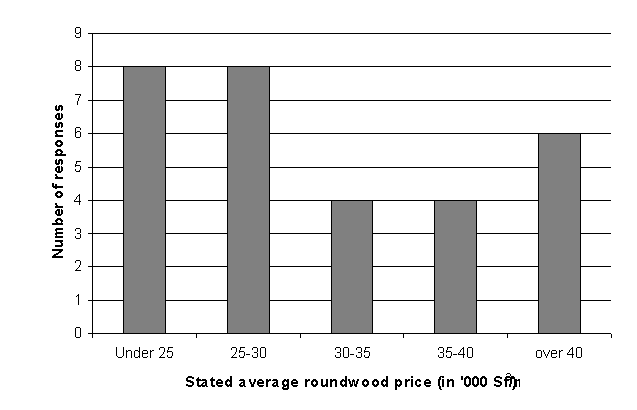
Figure 3 Delivered roundwood prices recorded in the 1999 sawmill survey
Source: LBB
Domestic roundwood prices
Figure 3 shows the delivered roundwood prices recorded in the 1999 sawmill survey carried-out by LBB. As the figure shows, there is considerable variation between responses. Some sawmills claim to be able to pay up to Sf 55,000/m3 (US$ 40.75/m3) for their roundwood input, while others claim to be able to pay only Sf 15,000/m3 (US$ 11.10/m3). As noted earlier, there is an incentive for sawmillers to understate these prices in order to give the impression that they can not afford to pay higher levies. Furthermore, if some of them can afford to pay up to Sf 55,000/m3, the question that must be asked is: why can't all of them?
In view of the fact that one of the objectives of the forest charging policy should be to encourage the most efficient forest processors to grow (even if it means that this will take place at the expense of the less efficient forest processors), prices from the higher end of the ranges given to LBB have been used in this analysis (see Table 1). This analysis has therefore, used an average price for roundwood sold in the domestic market of Sf 45,000/m3 (US$ 33.35/m3) for Grade A species and Sf 40,000/m3 (US$ 29.65/m3) for Grade B species, in order to calculate the economic rent from roundwood production.
Generally, these domestic market prices are still quite low in comparison with the delivered price of roundwood in other tropical countries.
Table 1 Prices paid for roundwood delivered to Paramaribo in August 1999
|
Type of roundwood and market |
Price per cubic metre (in US$) |
Price per cubic metre (in Sf) |
|
Minimum export prices set by the Suriname Government |
110 120 |
148,500 162,000 |
|
Prices paid for roundwood by exporters |
45 60 |
60,750 81,000 |
|
First-grade roundwood for the domestic market |
30 33 |
40,000 45,000 |
|
Second-grade roundwood for the domestic market |
26 30 |
35,000 40,000 |
|
Third-grade roundwood for the domestic market |
22 26 |
30,000 -35,000 |
Source: Whiteman (1999b), updated with LBB sawmill survey (1999). Note that the prices have been converted between US$ and Sf at the current (August 1999) market exchange rate of around Sf 1,350 to US$ 1.00. Roundwood for export is generally traded in US$, while roundwood for the domestic market is bought and sold in Suriname Guilders. The prices shown in italics are the prices converted from the currency that is generally used for payment to the other currency.
Export roundwood prices
The minimum export price set by the Government of Suriname is the price used for the calculation of export levies and the remittance of foreign currency to the Central Bank of Suriname. The minimum prices shown in Table 1 were introduced in October 1998. Before this, the minimum prices for roundwood exports were set at US$ 90/m3 for Grade A species and US$ 75/m3 for Grade B species.
Nearly all roundwood exported from Suriname in 1998 was exported at a declared price equal to the minimum price set by the Government. These prices have, therefore, been used in the analysis. It is likely however that, using offshore companies, the true price paid to many roundwood exporters was higher than this. For example, exports of roundwood from neighbouring Guyana in 1997 (Guyana Forestry Commission, 1998) were somewhat higher than this (e.g. US$ 169/m3 for Wallaba and US$ 322/m3 for Greenheart). Although the type and quality of roundwood exported from Guyana may be different to that exported from Suriname, this does suggest that the real value of roundwood exported from Suriname might be somewhat higher than the declared value reported here.
With respect to the export roundwood prices, one final point worth noting is the difference between the export price and the prices paid by exporters to roundwood producers. A number of timber traders have been established in recent years in Suriname and the prices that they pay for export quality roundwood is roughly half the minimum export price (although they are still generally well above domestic roundwood prices). These traders may incur some costs (e.g. port handling charges and the cost of holding small parcels of timber until they have enough to make a shipment) but this is a fairly clear indication of rent capture on the part of the timber traders. In their case, they are probably capitalising on having a certain amount of control over export facilities (another relatively fixed factor of production that can generate economic rent).
As noted above, roundwood production costs can vary due to a range of factors outside and within the forest managers' control. Therefore, as a starting point for this analysis, the production cost for a "typical" or "representative" forest operation has been constructed. A sensitivity analysis has then examined variations in the total roundwood production cost, due to variations in the three factors that are likely to have the greatest impact on costs: transport distance; harvesting intensity; and the size of the annual cutting area.
The total roundwood production cost for a "typical" forest operation
The four broad main factors that influence roundwood production costs are: the area being cut each year; the harvesting intensity (and thus, annual production from the area); the harvesting, extraction and transport methods currently used to get timber from the forest to the market; and the average transport distance. Information about each of these variables has been collected from studies of the harvesting sector in Suriname and discussions with forest managers.
Cutting area. The majority of forest operations in Suriname are small-scale logging operations managed either by small to medium-sized sawmills or by some of the larger independent logging companies. Mitchell (1998a) shows that the average size of the old or former forest concessions in Suriname (many of which are still being logged) is about 12,000 ha. Assuming a cutting cycle of 25 years, this would suggest that about 480 ha is logged each year. However, it is believed that most concessionaires are currently repeatedly cutting over a much smaller area. Hendrison (1990), for example, found an annual cutting area of only 220 ha in his study of logging in Suriname and this was in a large and relatively well-equipped forest concession. Discussions with forest managers confirmed that generally only very small areas are currently being harvested each year. Therefore, an annual cutting area of 220 ha has been used in this analysis as representative of a "typical" forest operation currently working in Suriname.
Harvesting intensity. Information about the sustainable yield from the natural forest in Suriname is subject to some uncertainty. Results of the CELOS research experiments suggest that a yield of 20 m3/ha with a cutting cycle of 20-25 years may be possible across much of the area. However, this is partly dependent on the application of silvicultural measures that are not generally applied in Suriname. In terms of current practices, a figure of 17.5 m3/ha has been used in this analysis, again based on observations made by Hendrison (1990). Thus, by taking this estimate and multiplying it by 220 ha, these figures would suggest that the current level of production in a "typical" forest operation in Suriname might be around 3,850 m3/year.
Production techniques. Current harvesting practices in Suriname are quite inefficient and productivity is generally low. In terms of their impact on production costs, the two most important aspects of current practices are the skidding techniques used in the forest and the transport equipment used to transport roundwood from the forest to the market. The calculation of skidding costs has been based on the estimated existing road density of 5 m/ha, with an assumption that no new forest roads are being built. This is a very low road density and results in long skid-trails for roundwood extraction. However, it is believed that this is typical of current forest practices in Suriname. The absence of any road building also means that the cost of road building has not been included in the production cost calculation. In terms of transport equipment, the analysis has assumed that the typical forest operation uses trucks with a relatively small carrying-capacity (20 m3). Such trucks (often home-made) are commonly used in forest operations in Suriname today.
Transport distances. Most of the former forest concessions in Suriname are located in the "forest belt". This strip starts between 5 km and 20 km from the coast and reaches up to 80 km to 100 km inland. A few sawmills are located within the forest or part of the way up some of the larger rivers reaching into the interior of Suriname, but the majority of them are located in the coastal towns of Paramaribo, Nickerie, and Moengo. Based on the location of most sawmills and former forest concessions therefore, it has been assumed that the average haulage distance from forest to sawmill is 85 km and that all roundwood is transported entirely by road.
The total roundwood production cost that has been estimated for a "typical" forest operation in Suriname is shown in Figure 4. The total roundwood production cost is estimated to be just under Sf 32,000/m3 (US$ 23.50/m3). This cost is broadly comparable with the total roundwood production cost in many other tropical countries, but is relatively high in view of the transport distance (which is generally much shorter than in many other tropical countries).

Figure 4 The estimated total roundwood production cost in Suriname in 1999 (by production activity)
The figure shows that skidding and transport costs account for the majority of the total roundwood production cost (37% and 35% respectively). Felling costs are generally quite low because a large proportion of the felling cost is the cost of labour, which is comparatively cheap compared with the cost of machinery (which has to be imported).
Loading costs here assume that contractors are used in the many small-scale forest operations currently typical in Suriname. The forest loader is the piece of equipment with the greatest level of productivity (in terms of the volume of roundwood it can handle in a day). For example, one forest loader could handle at least four times the level of production assumed here (and probably much more in a really efficient operation). In situations where small-scale forest operators are using their own loaders, it is likely that the total roundwood production cost is somewhat higher than shown here due to the low utilisation of this particular piece of equipment.
The distribution of the total roundwood production cost between the four different types of cost is shown in Figure 5. Labour and consumables account for about one-third of the total roundwood production cost, while the capital cost and normal profit (i.e. expected return on capital) account for two-thirds of the total.
The largest shares of the total roundwood production cost are the capital cost and normal profit. This is an indication of how important it is to maximise capital utilisation rates in the forestry sector. This can only be achieved by using the machinery for longer, which, in turn, generally requires a larger production volume from each forest operation that is currently achieved.
The cost of labour is a cost in local currency, as is a proportion of the cost of consumable items used in the production process. However, the majority of capital costs are foreign currency costs (i.e. capital equipment and spare part are mostly imported). Therefore, another consequence of the high share of the total roundwood production cost accounted for by capital costs is that the total cost is very sensitive to the exchange rate.

Figure 5 The estimated total roundwood production cost in Suriname in 1999 (by type of cost)
The impact of transport distance on the total roundwood production cost
The impact of transport distance on the total roundwood production cost in Suriname is shown in Figure 6. The figures presented here have been calculated by varying the transport distance in the roundwood production cost model, but keeping the other variables the same (i.e. the figures are the estimated roundwood production costs for "typical" forest operations at a range of distances from the market).
The figure shows that, as transport distances increase, the total roundwood production cost becomes greater at a rate of roughly Sf 110/m3 (or US$ 0.12/m3) per kilometre. Transport costs increase with distance not only because more fuel is consumed transporting roundwood over longer distances but also because, as distances extend, more trucks have to be used to keep-up with production. Only one truck would be required to deliver the volume of timber produced by the "typical" forest operation up to a distance of around 100 km. Beyond this point, contract transport would have to be used to supplement the forest managers equipment up until a transport distance of around 150 km, at which point the use of a second truck could be justified.
The estimates presented in Figure 6 also assume that all roundwood is transported by road. Some forest concessions in Suriname use barges or pontoons to transport timber. Water transport is generally much cheaper per km because large volumes of timber can be transported on each trip. However, again, the cost is sensitive to the level of utilisation. The cost of water transport can also be much higher than road transport due to the need to unload and re-load roundwood from trucks onto barges. Generally, water transport starts to become a more attractive option than road transport at distances of around 150 km (less with higher production volumes). Therefore, beyond this point, the average increase in transport costs per additional kilometre may be lower than suggested above.

Figure 6 The impact of transport distance on the total roundwood production cost in Suriname in 1999
The impact of harvesting intensity on production cost
Figure 7 shows the impact of harvesting intensity on the total roundwood production cost, for three levels of harvesting intensity (20 m3/ha, 16 m3/ha and 12 m3/ha). At the lowest level of harvesting intensity (12 m3/ha) the total roundwood production cost is about Sf 41,650/m3 (US$ 30.85/m3), while at the highest level of harvesting intensity (20 m3/ha) the total roundwood production cost is only about Sf 28,950/m3 (US$ 21.40/m3). The difference between these two figures is significant (Sf 12,700/m3 or US$ 9.45/m3) and shows how more intensive use of the forest can reduce the total roundwood production cost substantially.
The higher level of harvesting intensity results in a much lower total roundwood production cost for two reasons. Firstly, a higher harvesting intensity will result in higher overall production and generally better capital utilisation. This will result in a lower capital cost of production (i.e. the cost of machinery used in the forestry operation will be spread over a greater volume of production). The second reason is that, because a greater volume is removed from each hectare, the average extraction cost will be lower (i.e. the cost of creating skid trails will be spread over a larger volume of production).
The CELOS silvicultural trials suggest that a harvesting intensity of 20 m3/ha should be possible from much of the natural forest area in Suriname. Therefore, bearing in mind the major impact that harvesting intensity can have on the total roundwood production cost, the forest charging system should try to encourage the highest level of harvesting intensity that is possible, which may be around 20 m3/ha in many cases.
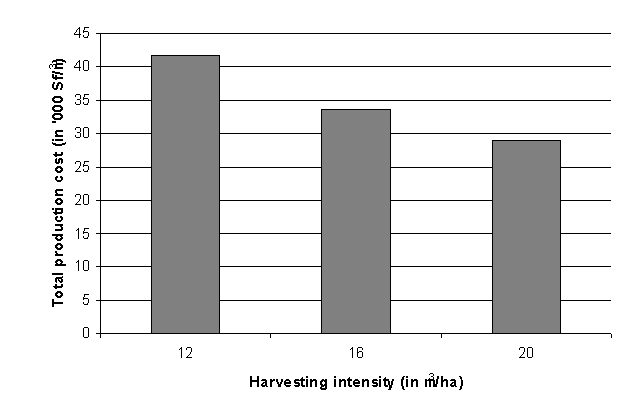
Figure 7 The impact of harvesting intensity on the total roundwood production cost in Suriname in 1999
The impact of the scale of operations on production cost
This size of the "typical" forest operation examined here is believed to be broadly representative of the scale of operations of most forest concessionaires and sawmillers with forest concessions currently operating in Suriname. In comparison with forest concessions in the natural forest in other tropical countries, the annual cutting area of only 220 ha is very small.
Figure 8 shows the impact of the scale of operations on the total delivered roundwood production cost for three scales of operation (annual cutting areas of 200 ha, 400 ha and 600 ha). At the smallest scale of operations (200 ha/year) the total roundwood production cost is about Sf 31,700/m3 (US$ 23.50/m3), while at the largest scale of operations (600 ha/year) the total roundwood production cost is only about Sf 28,850/m3 (US$ 21.40/m3). An even larger scale of operations than examined here would result in further cost savings, but would not reduce the total roundwood production cost by much further under existing forest harvesting practices.
The difference between these two figures is not that great (Sf 2,850/m3 or US$ 2.10/m3), because the only major benefit from a larger scale of operations is higher overall production and generally better capital utilisation. However, in view of the fact that a certain amount of planning and infrastructure development (i.e. road building) would be desirable in the sector in future, it is likely that an annual cutting area of at least 600 ha should be encouraged. With a 25 year cutting cycle, this would suggest a total minimum forest concession size of around 15,000 ha.
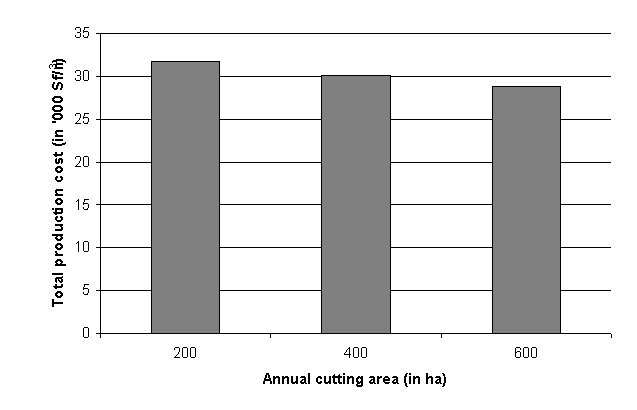
Figure 8 The impact of the scale of operations on the total roundwood production cost in Suriname in 1999
Based on the cost and price information presented above, the level of economic rent generated from roundwood production in Suriname has been estimated for a range of situations. In view of the very different prices paid for roundwood in the domestic and export markets, these results are presented separately for each of these markets.
Economic rent from roundwood produced for the domestic market
Based on an average delivered roundwood price of around Sf 45,000/m3 (US$ 33.35/m3) for Grade A species and total roundwood production costs (depending upon transport distance and harvesting intensity) varying from Sf 38,000/m3 (US$ 28.15/m3) to Sf 27,000/m3 (US$ 20.00/m3), the range of likely economic rents from roundwood production in Suriname has been calculated and is shown in Table 2. Economic rent from the production of Grade B species is likely to be Sf 5,000/m3 (US$ 3.70/m3) less than the figures shown in this table, due to the generally lower prices paid for roundwood of these species.
Table 2 The likely range of economic rent from roundwood production (Grade A species) for the domestic market in Suriname in 1999
|
Transport |
Harvesting intensity (in m3/ha) |
||
|
Distance (in km) |
16 |
18 |
20 |
|
65 |
Sf 13,525/m3 (US$ 10.00/m3) |
Sf 15,500/m3 (US$ 11.50/m3) |
Sf 18,250/m3 (US$ 13.50/m3) |
|
85 |
Sf 11,325/m3 (US$ 8.40/m3) |
Sf 13,300/m3 (US$ 9.85/m3) |
Sf 16,050/m3 (US$ 11.90/m3) |
|
125 |
Sf 6,925/m3 (US$ 5.15/m3) |
Sf 8,900/m3 (US$ 6.60/m3) |
Sf 11,650/m3 (US$ 8.65/m3) |
Note: harvesting intensity and transport distance have been chosen as the two factors that are most likely to vary between different forest concessionaires under current harvesting practices. Prices paid for Grade B species are generally around Sf 5,000/m3 (US$ 3.70/m3) less than prices paid for Grade A species, Consequently, the economic rent from the production of Grade B species is also likely to be around Sf 5,000/m3 (US$ 3.70/m3) less than the figures shown in this table.
Taking into account the current mixture of Grade A species and Grade B species produced in Suriname, the average economic rent from roundwood production probably varies from a little under Sf 5,000/m3 (US$ 3.70/m3) to just over Sf 16,000/m3 (US$ 11.85/m3) depending upon location and harvesting intensity. However, it is unlikely that much roundwood is produced at the lower end of this range, because the most distant forest areas in Suriname are also probably relatively undisturbed, such that it is easier to harvest at a relatively high intensity in these areas. (It would also not make much sense because the lowest level of economic rent shown in Table 2 is also below the current forest levy in Suriname). Based on the current location of forest concessions and other cutting areas and the typical intensity of harvesting in Suriname, the results of this analysis would suggest that the overall average level of economic rent from roundwood produced for the domestic market might be around Sf 11,000/m3 (US$ 8.15/m3).
Economic rent from roundwood produced for the export market
In the case of roundwood produced for the export market, the economic rent from such production is much higher, because the production cost is more or less the same (with the exception of a few port-handling charges), but the export value of the roundwood is much higher. However, due to the foreign exchange policy currently in place in Suriname, the economic rent calculation must take into account the part of the economic rent that is already captured by the operation of the "official exchange rate" policy.
The whole of this economic rent analysis has been performed at the market exchange rate (which is currently August 1999 around Sf 1,350 to the US dollar). However, if roundwood is exported, all foreign exchange earned from such exports (usually equal to the minimum export value set by the government) must be converted into Suriname Guilders at the official exchange rate (Sf 850 to the US dollar). This policy captures a significant share of the hard currency earned from exports and is equivalent to a tax of around 40% on all exports from Suriname. Therefore, in the calculation of economic rent from roundwood produced for export, this amount has to be subtracted from the roundwood export price in order to arrive at the remaining amount of economic rent that can be captured through forest levies.
The calculation of economic rent from roundwood produced for the export market is shown in Table 3. This shows that, after accounting for the average total roundwood production cost (converted from Surname Guilders to US$ at the market exchange rate), port handling charges (in US$) and the loss of foreign exchange on conversion back into Suriname Guilders at the official exchange rate, the average level of economic rent from roundwood production for the export market varies from US$ 42/m3 for the higher value species to US$ 36/m3 for the lower value species.
Table 3 The calculation of economic rent from roundwood produced for the export market in Suriname in 1999
|
Roundwood export price |
120 |
110 |
||
|
less Loss on conversion of foreign exchange at the official exchange rate |
45 |
41 |
||
|
less Total roundwood production cost |
23 |
23 |
||
|
less Port handling charges |
10 |
10 |
||
|
ECONOMIC RENT |
42 |
36 |
||
Note: the difference between the market and official rates of exchange is equivalent to a tax of about 40% on exports. Strictly speaking, for the purposes of calculating economic rent, this is not a real cost of production, but another government levy (on exporting products). However, for the purposes of estimating the forest levy that should be charged on roundwood production it has to be treated as a cost of production.
It should be noted that, if the dual exchange rate policy was removed in Suriname, the revenues (to the exporter) from exporting roundwood would be considerably higher and the export levy on roundwood exports could consequently, be set at a much higher level (e.g. around +US$ 40/m3) than is suggested later in this document.
Comparison with November 1998
In order to examine how the recent devaluation of the Suriname Guilder has affected the forestry sector, the results presented here have been compared with the results obtained using the data collected in November 1998. A comparison between the production costs, roundwood prices and the average level of economic rent from roundwood produced for the domestic market is shown in Figure 9.
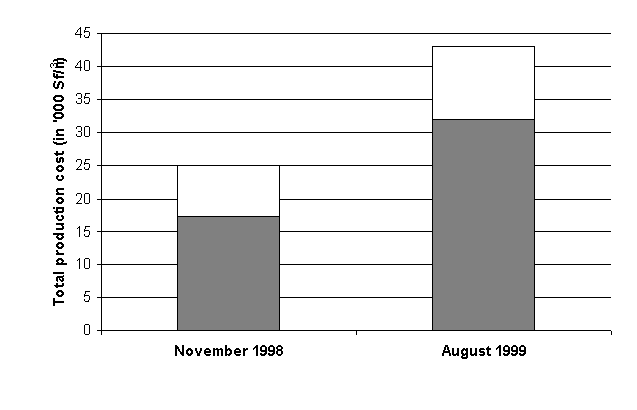
Figure 9 A comparison between (local currency) costs, prices and the economic rent from roundwood production in Suriname in November 1998 and August 1999
The delivered roundwood price in November 1998 varied from Sf 15,000/m3 (US$ 23.10/m3) to Sf 25,000/m3 (US$ 38.45/m3) and the higher end of this range (Sf 25,000/m3 or US$ 38.45/m3) has been used in this analysis. This was the price paid for roundwood for processing in the domestic market (the export price, set by the government, was the same as it is now). The average total roundwood production cost in November 1999 (the dark shaded area in the figure) was estimated to be Sf 17,200/m3 (US$ 26.45/m3), leaving an estimated average level of economic rent (the unshaded area) of just under Sf 8,000/m3. This is somewhat less than the current estimated economic rent of Sf 11,000/m3, but more in US$ terms (US$ 12.30/m3 then, at the market exchange rate in November 1998, as opposed to US$ 8.15/m3 now). It appears, therefore, that roundwood producers have been able to pass on their increased production costs and a slight increase in economic rent (in terms of the local currency) to the purchasers of their roundwood, although they are slightly worse off than they were before in US$ terms.
The comparison in costs, prices and economic rent from roundwood produced for the export market is shown in Figure 10. In contrast to the situation in the local market, roundwood produced for the export market has become relatively cheaper to produce (in foreign currency terms) by around US$ 3.00/m3 (a reduction from US$ 36.60/m3 to US$ 33.50/m3). This is due to the slightly lower cost (in foreign currency terms) of items purchased in Suriname Guilders (particularly the cost of labour). The difference between the market exchange rate and official exchange rate is remarkably similar (about 40%) in both instances, such that the economic rent from roundwood produced for export has increased very slightly, from US$ 39.00/m3 to US$ 41.50/m3.
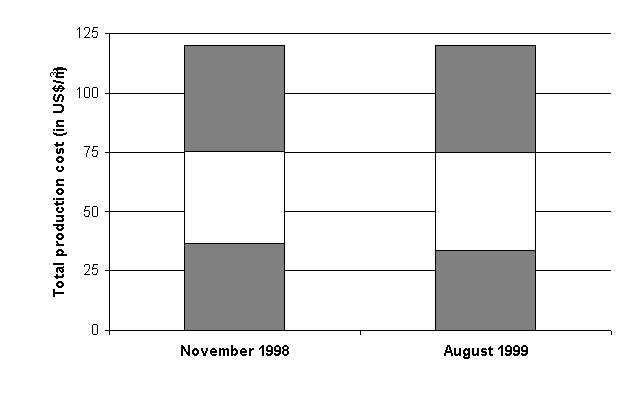
Figure 10 A comparison between (foreign currency) costs, prices and the economic rent from roundwood production in Suriname in November 1998 and August 1999